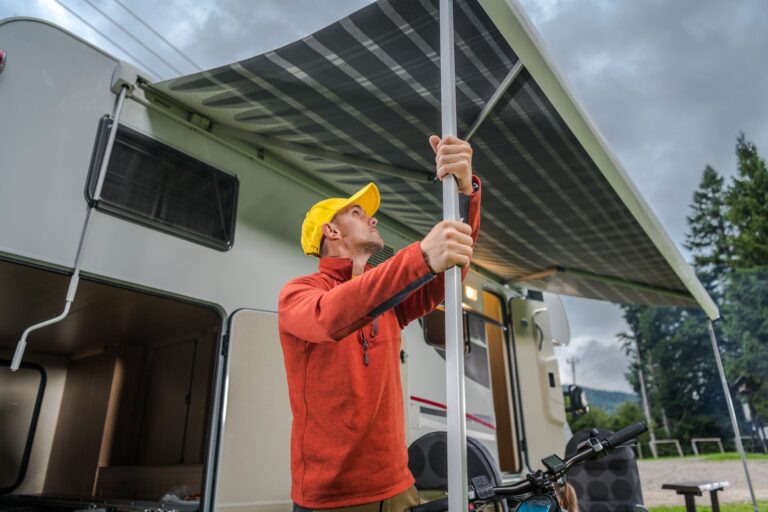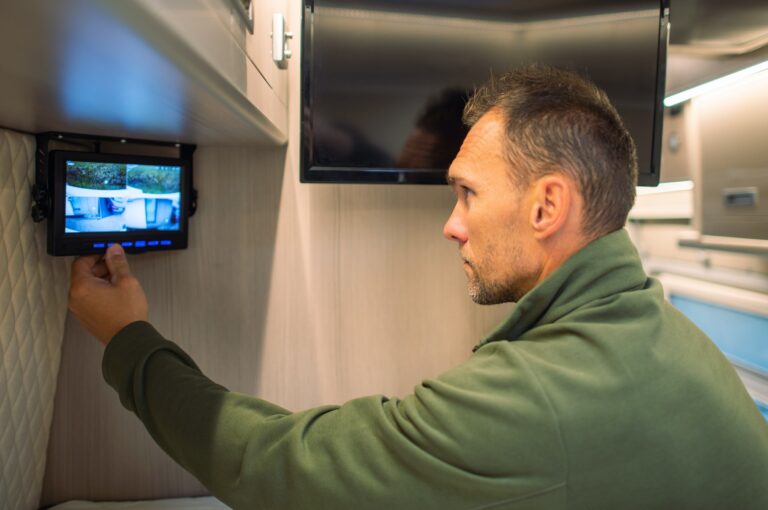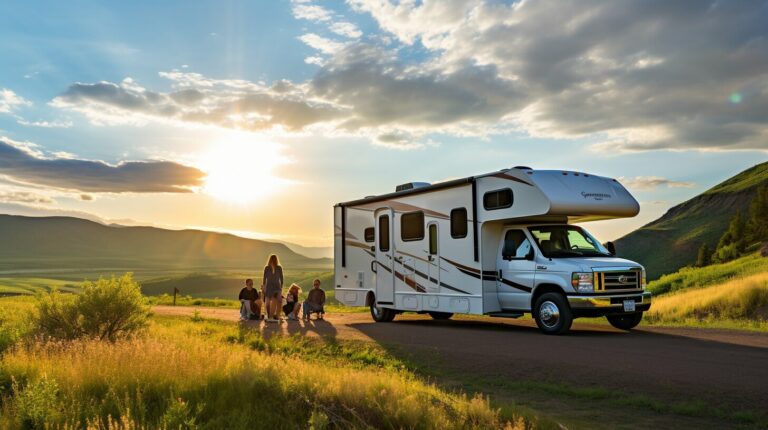Driving an RV can be an exhilarating experience, allowing you the freedom to explore the open road and enjoy the comforts of home while doing so. However, maneuvering a large vehicle like an RV can also be challenging, particularly for those who are new to the world of recreational vehicles. In this comprehensive guide, we’ll discuss how to drive an RV safely, covering essential topics such as vehicle preparation, handling techniques, and navigating various road conditions.
1. Preparing Your RV for the Road
Before hitting the road in your RV, it’s essential to make sure your vehicle is in top condition and properly equipped for safe travel. Taking the time to prepare your RV can help prevent accidents and ensure a smoother, more enjoyable journey.
Key tips for preparing your RV:
- Familiarize Yourself with Your RV: Read the owner’s manual and gain an understanding of your RV’s features, systems, and controls. Practice driving in a safe, low-traffic area before embarking on your first trip.
- Perform Regular Maintenance: Keep up with routine maintenance tasks such as checking tire pressure, fluid levels, and brake function. Regularly inspect your RV for signs of wear or damage that could impact its performance or safety.
- Secure Your Belongings: Make sure all items inside your RV are securely stowed to prevent them from shifting or falling during transit, which could cause damage or injury.
- Adjust Your Mirrors: Properly adjusted mirrors are crucial for safe driving. Ensure you have a clear view of the sides and rear of your RV, and consider adding extended mirrors if necessary.
- Plan Your Route: Research your travel route in advance, taking into consideration factors such as road conditions, weather, and potential obstacles like low-clearance bridges or tunnels.
2. Mastering RV Handling Techniques
Driving an RV is significantly different from driving a standard passenger vehicle. It’s essential to learn and practice RV-specific handling techniques to navigate the roads safely and confidently.
Essential RV handling techniques:
- Be Mindful of Your RV’s Size: Remember that your RV is larger and heavier than a standard vehicle, which means it will take longer to accelerate, decelerate, and change direction. Give yourself plenty of space and time to maneuver.
- Use Caution When Cornering: Due to their size and high center of gravity, RVs are more prone to rollovers than smaller vehicles. Slow down before entering curves and maintain a steady speed throughout the turn to prevent tipping or loss of control.
- Manage Your Blind Spots: Be aware of your RV’s blind spots, which are typically larger than those of a standard vehicle. Use your mirrors and turn signals, and be cautious when changing lanes or merging onto highways.
- Practice Defensive Driving: Stay alert and maintain a safe following distance to give yourself ample time to react to potential hazards. Be prepared for sudden stops, lane changes, or obstacles in the road.
- Learn to Brake Properly: Avoid sudden, hard braking, which can cause skidding or loss of control. Instead, apply steady, gradual pressure to the brakes, allowing your RV to come to a smooth, controlled stop.
3. Navigating Different Road Conditions
RV drivers must be prepared to navigate various road conditions, from congested city streets to winding mountain roads. Adapting your driving techniques to suit different environments can help ensure a safe and comfortable journey.
Tips for navigating different road conditions:
- City Driving: Be mindful of your RV’s size and avoid tight spaces or low-clearance areas. Use caution when making turns, and be prepared for frequent stops and starts in traffic.
- Rural Roads: Be prepared for narrow, winding roads and limited visibility. Slow down and use caution when approaching curves, hills, or intersections.
- Mountain Driving: Be prepared for steep inclines, sharp turns, and changing weather conditions. Downshift to a lower gear to maintain control when ascending or descending steep grades, and use engine braking to help preserve your brakes.
- Wet or Slippery Roads: Slow down and increase your following distance in wet or slippery conditions. Avoid sudden movements or hard braking, which can cause skidding or loss of control.
- Night Driving: Ensure your headlights are functioning properly and use your high beams when appropriate to improve visibility. Be alert for animals, pedestrians, or other obstacles that may be difficult to see in the dark.
4. Overcoming Common RV Driving Challenges
New and experienced RV drivers alike may encounter unique challenges on the road. By understanding these challenges and learning how to overcome them, you can improve your driving skills and confidence.
Common RV driving challenges and solutions:
- Backing Up: Due to their size and limited visibility, backing up in an RV can be difficult. Use a spotter to guide you, or invest in a rearview camera system to improve visibility.
- Parking: Practice parking in a variety of situations, such as parallel, angled, orperpendicular parking. Look for designated RV parking spaces, and consider using leveling blocks to ensure your RV is stable and level once parked.
- Fueling Up: Choose gas stations with ample space for maneuvering your RV, and be aware of your vehicle’s fuel capacity and consumption to avoid running out of gas.
- Low-Clearance Obstacles: Know your RV’s height and be mindful of low-clearance bridges, tunnels, or overpasses. Plan your route to avoid low-clearance obstacles whenever possible.
- Wind Resistance: Be prepared for the effects of wind resistance on your RV, which can cause swaying or difficulty steering. Slow down, maintain a firm grip on the steering wheel, and consider installing sway bars or other stabilization equipment.
5. Promoting Safety and Comfort for Passengers and Pets
Ensuring the safety and comfort of your passengers and pets is a critical aspect of RV travel. By taking steps to promote a secure and enjoyable environment, you can help everyone on board have a positive experience.
Tips for ensuring passenger and pet safety and comfort:
- Buckle Up: Encourage all passengers to wear seatbelts while the RV is in motion. If your RV is equipped with a dinette or sofa seating, ensure that passengers are safely secured using any available seatbelts.
- Secure Pets: Keep pets safely contained during travel, using a crate, travel carrier, or pet harness designed for use in vehicles. This not only protects your pets but also prevents them from becoming a distraction to the driver.
- Provide Entertainment: Bring along games, books, or electronic devices to keep passengers entertained during long stretches of travel. Don’t forget to pack headphones or earbuds to minimize noise and distractions for the driver.
- Plan Regular Breaks: Schedule stops every 2-3 hours to give passengers and pets a chance to stretch their legs, use the restroom, or get some fresh air. This can help prevent fatigue and restlessness during long trips.
- Monitor Temperature and Ventilation: Keep the interior of your RV at a comfortable temperature and ensure adequate ventilation, especially in hot or cold weather. Never leave pets or children unattended inside a parked RV, as temperatures can quickly become dangerous.
By following these guidelines and practicing safe RV driving techniques, you can confidently navigate the roads in your new home on wheels. Remember to always prioritize safety, be aware of your surroundings, and adapt your driving to suit different road conditions and environments. With proper preparation and a commitment to responsible RV operation, you’ll be well-equipped to enjoy the freedom and adventure of the open road.






